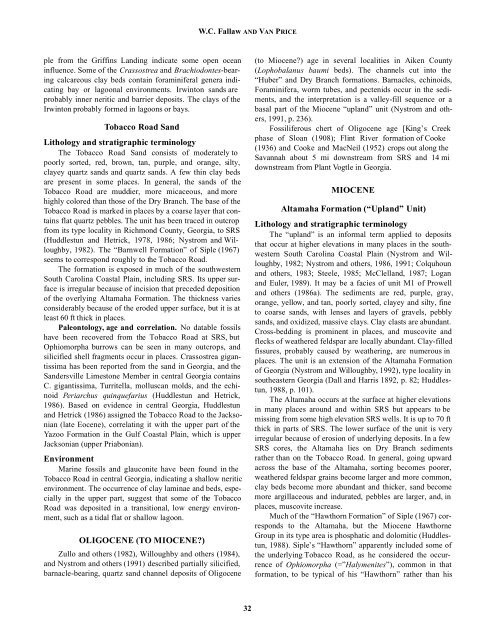Download Guidebook as .pdf (1.8 Mb) - Carolina Geological Society
Download Guidebook as .pdf (1.8 Mb) - Carolina Geological Society
Download Guidebook as .pdf (1.8 Mb) - Carolina Geological Society
Create successful ePaper yourself
Turn your PDF publications into a flip-book with our unique Google optimized e-Paper software.
W.C. Fallaw AND VAN PRICE<br />
ple from the Griffins Landing indicate some open ocean<br />
influence. Some of the Cr<strong>as</strong>sostrea and Brachiodontes-bearing<br />
calcareous clay beds contain foraminiferal genera indicating<br />
bay or lagoonal environments. Irwinton sands are<br />
probably inner neritic and barrier deposits. The clays of the<br />
Irwinton probably formed in lagoons or bays.<br />
Tobacco Road Sand<br />
Lithology and stratigraphic terminology<br />
The Tobacco Road Sand consists of moderately to<br />
poorly sorted, red, brown, tan, purple, and orange, silty,<br />
clayey quartz sands and quartz sands. A few thin clay beds<br />
are present in some places. In general, the sands of the<br />
Tobacco Road are muddier, more micaceous, and more<br />
highly colored than those of the Dry Branch. The b<strong>as</strong>e of the<br />
Tobacco Road is marked in places by a coarse layer that contains<br />
flat quartz pebbles. The unit h<strong>as</strong> been traced in outcrop<br />
from its type locality in Richmond County, Georgia, to SRS<br />
(Huddlestun and Hetrick, 1978, 1986; Nystrom and Willoughby,<br />
1982). The “Barnwell Formation” of Siple (1967)<br />
seems to correspond roughly to the Tobacco Road.<br />
The formation is exposed in much of the southwestern<br />
South <strong>Carolina</strong> Co<strong>as</strong>tal Plain, including SRS. Its upper surface<br />
is irregular because of incision that preceded deposition<br />
of the overlying Altamaha Formation. The thickness varies<br />
considerably because of the eroded upper surface, but it is at<br />
le<strong>as</strong>t 60 ft thick in places.<br />
Paleontology, age and correlation. No datable fossils<br />
have been recovered from the Tobacco Road at SRS, but<br />
Ophiomorpha burrows can be seen in many outcrops, and<br />
silicified shell fragments occur in places. Cr<strong>as</strong>sostrea gigantissima<br />
h<strong>as</strong> been reported from the sand in Georgia, and the<br />
Sandersville Limestone Member in central Georgia contains<br />
C. gigantissima, Turritella, molluscan molds, and the echinoid<br />
Periarchus quinquefarius (Huddlestun and Hetrick,<br />
1986). B<strong>as</strong>ed on evidence in central Georgia, Huddlestun<br />
and Hetrick (1986) <strong>as</strong>signed the Tobacco Road to the Jacksonian<br />
(late Eocene), correlating it with the upper part of the<br />
Yazoo Formation in the Gulf Co<strong>as</strong>tal Plain, which is upper<br />
Jacksonian (upper Priabonian).<br />
Environment<br />
Marine fossils and glauconite have been found in the<br />
Tobacco Road in central Georgia, indicating a shallow neritic<br />
environment. The occurrence of clay laminae and beds, especially<br />
in the upper part, suggest that some of the Tobacco<br />
Road w<strong>as</strong> deposited in a transitional, low energy environment,<br />
such <strong>as</strong> a tidal flat or shallow lagoon.<br />
OLIGOCENE (TO MIOCENE)<br />
Zullo and others (1982), Willoughby and others (1984),<br />
and Nystrom and others (1991) described partially silicified,<br />
barnacle-bearing, quartz sand channel deposits of Oligocene<br />
(to Miocene) age in several localities in Aiken County<br />
(Lophobalanus baumi beds). The channels cut into the<br />
“Huber” and Dry Branch formations. Barnacles, echinoids,<br />
Foraminifera, worm tubes, and pectenids occur in the sediments,<br />
and the interpretation is a valley-fill sequence or a<br />
b<strong>as</strong>al part of the Miocene “upland” unit (Nystrom and others,<br />
1991, p. 236).<br />
Fossiliferous chert of Oligocene age [King’s Creek<br />
ph<strong>as</strong>e of Sloan (1908); Flint River formation of Cooke<br />
(1936) and Cooke and MacNeil (1952) crops out along the<br />
Savannah about 5 mi downstream from SRS and 14 mi<br />
downstream from Plant Vogtle in Georgia.<br />
MIOCENE<br />
Altamaha Formation (“Upland” Unit)<br />
Lithology and stratigraphic terminology<br />
The “upland” is an informal term applied to deposits<br />
that occur at higher elevations in many places in the southwestern<br />
South <strong>Carolina</strong> Co<strong>as</strong>tal Plain (Nystrom and Willoughby,<br />
1982; Nystrom and others, 1986, 1991; Colquhoun<br />
and others, 1983; Steele, 1985; McClelland, 1987; Logan<br />
and Euler, 1989). It may be a facies of unit M1 of Prowell<br />
and others (1986a). The sediments are red, purple, gray,<br />
orange, yellow, and tan, poorly sorted, clayey and silty, fine<br />
to coarse sands, with lenses and layers of gravels, pebbly<br />
sands, and oxidized, m<strong>as</strong>sive clays. Clay cl<strong>as</strong>ts are abundant.<br />
Cross-bedding is prominent in places, and muscovite and<br />
flecks of weathered feldspar are locally abundant. Clay-filled<br />
fissures, probably caused by weathering, are numerous in<br />
places. The unit is an extension of the Altamaha Formation<br />
of Georgia (Nystrom and Willoughby, 1992), type locality in<br />
southe<strong>as</strong>tern Georgia (Dall and Harris 1892, p. 82; Huddlestun,<br />
1988, p. 101).<br />
The Altamaha occurs at the surface at higher elevations<br />
in many places around and within SRS but appears to be<br />
missing from some high elevation SRS wells. It is up to 70 ft<br />
thick in parts of SRS. The lower surface of the unit is very<br />
irregular because of erosion of underlying deposits. In a few<br />
SRS cores, the Altamaha lies on Dry Branch sediments<br />
rather than on the Tobacco Road. In general, going upward<br />
across the b<strong>as</strong>e of the Altamaha, sorting becomes poorer,<br />
weathered feldspar grains become larger and more common,<br />
clay beds become more abundant and thicker, sand become<br />
more argillaceous and indurated, pebbles are larger, and, in<br />
places, muscovite incre<strong>as</strong>e.<br />
Much of the “Hawthorn Formation” of Siple (1967) corresponds<br />
to the Altamaha, but the Miocene Hawthorne<br />
Group in its type area is phosphatic and dolomitic (Huddlestun,<br />
1988). Siple’s “Hawthorn” apparently included some of<br />
the underlying Tobacco Road, <strong>as</strong> he considered the occurrence<br />
of Ophiomorpha (=”Halymenites”), common in that<br />
formation, to be typical of his “Hawthorn” rather than his<br />
32













